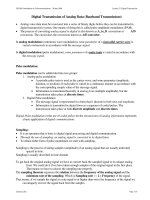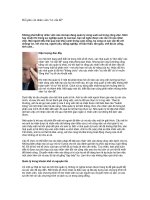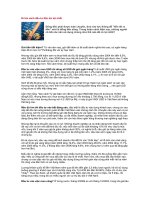Tài liệu Lecture 6b Manufacturing - CAM: Instructor(s) Prof. Olivier de Weck doc
Bạn đang xem bản rút gọn của tài liệu. Xem và tải ngay bản đầy đủ của tài liệu tại đây (446.51 KB, 32 trang )
16.810
16.810
Engineering Design and Rapid Prototyping
Engineering Design and Rapid Prototyping
Instructor(s)
Manufacturing - CAM
January 25, 2007
Prof. Olivier de Weck
Lecture 6b
16.810
2
Outline
Introduction to Manufacturing
Parts Fabrication and Assembly
Metrics: Quality, Rate, Cost, Flexibility
Water Jet Cutting
OMax Introduction
Computer Aided (Assisted) Manufacturing
Converting a drawing to CNC Routing Instructions
16.810
3
Course Concept
today
16.810
4
Course Flow Diagram (2007)
CAD Introduction
FEM/Solid Mechanics
Avionics Prototyping
CAM Manufacturing
Hand sketching
Initial CAD design
FEM analysis
Optimization
Revise CAD design
Assembly
Parts Fabrication
Problem statement
Final Review
Test
Learning/Review Deliverables
(A) Requirements
and Interface
Document
(B) Hand Sketch
(D) Manufacturing
and Test Report
with Cost Estimate
(C) Solidworks CAD
Model, Performance
Analysis
Design Intro / Sketch
Fabrication,
Assembly, Testing
(E) CDR Package
+ Guest Lectures
16.810
5
Introduction to Manufacturing
Manufacturing is the
physical realization
of the
previously designed parts
Metrics to assess the “performance” of mfg
Quality
does it meet specifications?
Rate
how many units can we produce per unit time?
Cost
What is the cost per unit?
What is the investment cost in machinery & tooling?
Flexibility
what else can be make with our equipment?
How long does it take to reconfigure the plant?
16.810
6
Field
System/product
Beginning
of Lifecycle
-Mission
- Requirements
-Constraints
Customer
Stakeholder
User
Architect
Designer
System Engineer
Conceive
Design
Implement
“process information”
“turn
information
to matter”
SRR
PDR
CDR
iterate
iterate
The Environment
The Environment: technological, economic, political, social, nature
The Enterprise
The Enterprise
The System
The System
creativity
architecting
trade studies
modeling simulation
experiments
design techniques
optimization (MDO)
virtual
real
Manufacturing
assembly
integration
choose
create
Life Cycle: Conceive, Design, Implement
16.810
7
Simple Manufacturing Plant
Raw Materials
Energy
Supplied Parts
Labor
Money
Warehouse
PF1
…
PFn
QA1
…
QAn
Parts
Buffer
Supplier
Buffer
Assembly
Final
Inspection
Finished
Goods
PF = Parts Fabrication
(focus of this lecture)
QA = Quality Assurance
Sales
Scrap
Emissions
16.810
8
Raw Materials
Material
Selection
Strength
Density
Cost
…
Form
Sheet
Rods,
16.810
9
example: deck components
Ribbed-bulkheads
Approximate dimensions
250mm x 350mm x 30mm
Wall thickness = 2.54mm
Fundamental Parts Fabrication Techniques
Machining – e.g. milling, laser and waterjet cutting
Forming – e.g. deep drawing, forging, stamping
Casting - fill die with liquid material, let cool
Injection Molding - mainly polymers
Layup – e.g. Pre-preg composite manufacturing
Sintering - form parts starting from metal powder
decks
Parts Manufacturing
16.810
10
Quality: Engineering Tolerances
Tolerance The total amount by which
a specified dimension is
permitted to
vary
(ANSI Y14.5M)
Every component
within spec adds
to the yield (
Y
)
q
p
(q)
L
U
Y
y
p(y)
16.810
11
Process Capability Indices
Process Capability Index
Bias factor
Performance Index
(
)
C
UL
p
≡
− /2
3
σ
CC k
pk p
≡
−
()1
k
UL
UL
≡
−
+
−
μ
2
2()/
q
p(q)
L
U
UL
+
2
UL
−
2
16.810
12
Rate: Manufacturing
Typically: #of units/hour
The more parts we make (of the same
kind), the lower the cost/unit
Learning Curve effects
Higher Speed - Human learning
Reduced setup time
Fewer Mistakes (= less scarp=higher yield)
Bulk quantity discounts (=economies of
scale)
Better negotiating position with suppliers of
raw materials and parts
16.810
13
Learning Curve Equation
Credited to T.P. Wright [1936]
Model cost reduction between
first production unit and
subsequent units
Model the total production
cost of
N
units
()
B
total
CNTFUN
=
⋅
(
)
ln 100%
1
ln 2
S
B ≡−
TFU
= Theoretical first unit cost
S
= learning curve slope in %
> percentage reduction in cumulative
average cost, each time the number
of production units is doubled
Recommended:
2<N<10 S=95%
10<N<50 S=90%
N>50 S=85%
S=90% Learning Curve
0.00
0.20
0.40
0.60
0.80
1.00
1.20
1 3 5 7 9 11 13 15 17 19
Number of Units Produced
Cost/Unit
S=90%
B=0.85
TFU=1
16.810
14
Cost: Driving Factors
Cost/Unit [$]
Depends on
Manufacturing process chosen
Number of Parts made
Skill and Experience of worker(s), Salary
Quality of Raw Materials
Reliability of Equipment
Energy Costs
Land/Facility Cost
Tolerance Level (Quality)
16.810
15
Process Selection
tot fixed var
()CN C C N
=
+⋅
N - number of parts produced
- Machine
-Tools
- Training
-Time/part
-Material
-Energy
Fixed cost process 1
Total cost
process 2
Total
Manufacturing
Cost [$]
Total Cost
process 1
Fixed cost process 2
Choose
2
Choose
1
E.g.
Waterjet Cutting
E.g. Stamping
16.810
16
Waterjet - Brief history
- Industrial uses of ultra-high pressure waterjets began in the early 1970s.
Pressures: 40,000 ~ 60,000 psi
Nozzle diameter: 0.005"
- Special production line machines were developed to solve
manufacturing problems related to materials that had been previously
been cut with knives or mechanical cutters.
- Examples of early applications
Cardboard
Shapes from foam rubber
Soft gasket material
16.810
17
- In the early 1990s, John Olsen (pioneer of the waterjet cutting industry)
explored the concept of abrasive jet cutting.
- The new system equipped with a computerized control system that
eliminated the need for operator expertise and trial-and-error
programming.
- Olsen teamed up with Alex Slocum (MIT)
Used cutting test results and a theoretical cutting model by Rhode Island
University. Developed a unique abrasive waterjet cutter.
Waterjet - Brief history
16.810
18
Pumps
Intensifier Pump
- Early ultra-high pressure cutting systems used hydraulic intensifier pumps.
- At that time, the intensifier pump was the only pump for high pressure.
- Engine or electric motor drives the pump.
Pressure: ~ 60,000 psi
16.810
19
Crankshaft pump
- Use mechanical crankshaft to move any number of individual pistons
- Check valves in each cylinder allow water to enter the cylinder as the
plunger retracts and then exit the cylinder into the outlet manifold as the
plunger advances into the cylinder.
Pressure: ~ 55,000 psi
Reliability is higher.
Actual operating range of most systems
: 40,000 ~50,000 psi
An increasing number of abrasivejet systems
are being sold with the more efficient and
easily maintained crankshaft-type pumps.
Pumps
16.810
20
Two-stage nozzle design
[1] Water passes through a small-diameter jewel orifice to form a narrow jet.
Then passes through a small chamber pulling abrasive material.
[2] The abrasive particles and water pass into a long, hollow cylindrical
ceramic mixing tube. The resulting mix of abrasive and water exits the
mixing tube as a coherent stream and cuts the material.
Nozzles
Alignment of the jewel orifice and the mixing
tube is critical
In the past, the operator adjusted the alignment
often during operation.
16.810
21
X-Y Tables
Integrated
Separate
Gantry
Cantilever
x
y
z
Cutting table
Floor-mounted gantry with separate cutting table
Integrated table/gantry system
Floor-mounted cantilever system
with separate cutting table
Integrated table/cantilever system
16.810
22
Gantry
Cantilever
X-Y Tables : Gantry vs. Cantilever
Dis: Loading material onto the table can be
difficult because the gantry beam may interfere,
unless the gantry can be moved completely out
of the way
Dis: Because the gantry beam is moved at both
ends, a very high-quality electronic or
mechanical system must be employed to
ensure that both ends move precisely in unison
Adv: Well-adapted to the use of multiple
nozzles for large production runs
Dis: Y-axis is limited in length to about 5
feet because of structural considerations
16.810
23
Integrated
Separate
X-Y Tables: Separate vs. Integrated
Adv: Inherently better dynamic accuracy
because relative unwanted motion or
vibration between the table and X-Y
structure is eliminated
Dis: More expensive to build than the
traditional separate frame system
Adv: Less floor space is required for a given
table size because the external support
frame is eliminated
Adv: System accuracy can be built at the
factory and does not require extensive on-
site set-up and alignment
Which type is the Waterjet the in Aero/Astro machine shop?
Integrated table/cantilever system
Waterjet in Aero/Astro machine shop
OMAX Machining Center 2652
Integrated
cantilever
16.810
24
16.810
25
Control Systems
The OMAX control system computes exactly how the feed rate should vary for a
given geometry in a given material to make a precise part.
The algorithm actually determines desired variations in the feed rate every 0.0005"
(0.012 mm) along the tool path









